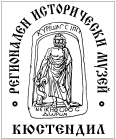 |
Menu  |
 |
|
»
»
»
»
»
»
»
»
»
»
»
»
»
»
|
|
|
|
 |
 |
 |
Numismatics  |
 |
|
I. Greek, Macedonian, Peony coins from the period V-I century B.C. The collection includes coins minted at the Greek towns Athens, Maroneia, Istiea on the isle of Eubeia, island of Thassos; the Macedonian rulers Philip II, Alexander III, Cassander, Antigonus Gonatus, Philip V, Perseus; autonomous town administration of Thessalonica, Pella, Amphipolis in the period II- I century B.C., coins from the First Macedonian Region and the roman questor Ezilas. The collection includes the collective coin finds from the village of Smochevo- coins of Philip V and Perseus; coins from the village of Laskarevo (Blagoevgrad region), Cherven bryag, Kyustendil region, the village of Krainitsi (Kyustendil), Kocherinovo - coins of the last Macedonian rulers and towns from III-I century B.C.; coins from Razlog- Athena (new style) and the isle of Thassos- second period; coins from the village of Visoka Mogila- bronze coins of Maroneia , as well as part of the treasure from the village of Rezhantsi with coins of the Peony ruler Patrai.
- Posthumous tetradrachma of Philip II, Amphipolis (315/4-295/4 B.C.), silver, inventory number 2667.
- Posthumous tetradrachma of Alexander III, Amphipolis (315-294, B.C.), silver, inventory number 83.
- Posthumous tetradrachma of Alexander III, Lampsak (310-301, B.C), silver, inventory number 2074.
- Celtic imitation of a tetradrachma of Alexander III, silver, inventory number 85.
- Tetradrachma of the Peony ruler Patrai (….), silver, inventory number 1652, treasure from the village of Rezhantsi.
- A coin from Perseus (179- 168 B.C.) bronze, inventory number 2222, treasure from the village of Smochevo
- A coin of Perseus (179- 168 B.C.) bronze, inventory number 2227, treasure from the village of Smochevo
- Tetradrachma of the city of Athens- new style (II-I century B.C.), silver, inventory number 97.
- Tetradrachma of the island of Thassos- second period (II-I century B.C.), silver, inventory number 2305, treasure from the town of Razlog.
|
 |
|
|
 
|
|
Roman republican and emperor coins. The collection contains silver and bronze coins, minted at the time of the Roman republic and empire, III century B.C.- V century. The collection also includes single coins, coin complexes from excavation in Kyustendil and the region, as well we collective coin finds from the village of Capitan Dimitrovo (Pazardjik region) consisting of roman republican denars (II-I century B.C.); coin finds from tombstone mounds in Dragodan anf Kocherinovo (II century)- Roman emperor denars; collective coin excavation from the Roman Therms in Pautalia (II-III century)- silver denars and antoniniani; collective find from the village of Kocherinovo (III century)- copper antoniniani and others.
- Roman republican denar (136 B.C.) silver, inventory number 4615, treasure from Capitan Andreevo village.
- Roman republican denar (127 B.C.) silver, inventory number 4619, treasure from Capitan Andreevo village.
- Roman republican denar (118 B.C.) silver, inventory number 4623, treasure from Capitan Andreevo village.
- Roman republican denar (88 B.C.) silver, inventory number 4636, treasure from Capitan Andreevo village.
- Roman republican denar (87 B.C.) silver, inventory number 4638, treasure from Capitan Andreevo village.
- Roman republican denar (82 B.C.) silver, inventory number 4646, treasure from Capitan Andreevo village.
- Denar of Emperor Hadrian (117-138) silver, inventory number 2644, Roman tomb mound in Dragodan village
- Denar of Emperor Antonin Pius (138- 161) silver, inventory number 2271
- Denar of Emperor Gordian III (238- 244), silver, inventory number 2726
- Antoninian of Emperor Philip I (244-249), silver, inventory number 2728
- Antoninian of Otacilia Severa, wife of Philip I, silver, inventory number 2728
|
 |
|
|
 
|
|
Collection of Roman bronze provincial coins. The collection includes coins minted by the provincial town administrations in the Roman Empire in the period I- III century- Serdika, Pautalia, Philipopolis, Augusta Traiana, Marcianopolis, Nicopolis ad Istrum, Nicopolis ad Nestum, Thessalonica, Nikea, Edesa, etc.
- Coin of Faustina II, wife of emperor Marc Aurelius (161-180), minted in Pautalia, bronze, inventory number 534
- Coin of Faustina II, wife of emperor Marc Aurelius (161-180), minted in Pautalia, bronze, inventory number 770
- Coin of Emperor Karakala (198- 217), minted in Pautalia, bronze, inventory number 47
- Coin of Emperor Karakala (198- 217), minted in Serdika, bronze, inventory number 4961
- Coin of emperor Komod (176- 192), minted in Philipopolis, bronze, inventory number 73
- Coin of emperor Elagabal (218- 222), minted in Philipopolis, bronze, inventory number 980
- Coin of emperor Karakala, (198-217) minted in Tomi, bronze, inventory number 21
- Coin of emperor Geta (209-212), minted in Tomi, bronze, inventory number 22
- Coin of emperor Alexander Sever (222- 235) and Julia Mameia, minted in Marcianopolis, bronze, inventory number 19
- Sacerdotal stamp of Pautalia (III century), bronze, inventory number 2116
|
 |
|
|
 
|
|
Collection Byzantine coins. The collection includes coins minted by the Byzantine Empire in the period VI-XIV century. The collection comprises single coins and collective coin finds from the following places: village of Korkina (Kyustendil)- coins from VI century; Kyustendil, Kocherinovo, the villages Lilyach, Tishanovo, Vukovo, Zhabokrut and others- Byzantine skiphats and Bulgarian and Latin imitations from XII-XIII centuries.
|
 |
|
|
 
|
|
Collection West European coins. The collection includes silver and golden coins, single and collective finds from almost every European country, which existed in XV-XIX centuries. The greatest amounts of coins come from Spain, Austro-Hungaria, Belgian confederation, Italian cities, etc.
- Coin of Giovanni Soranzo (1312-1328), Venice, silver, inventory number 1694
- Taller of the Belgian confederation, 1650, silver, inventory number…
- Gulden of Belgium, 1768, gold, inventory number 1465
|
 |
|
|
 
|
|
|
|

|



